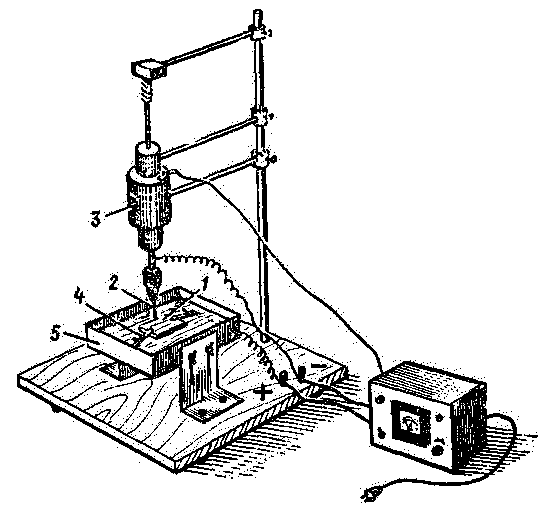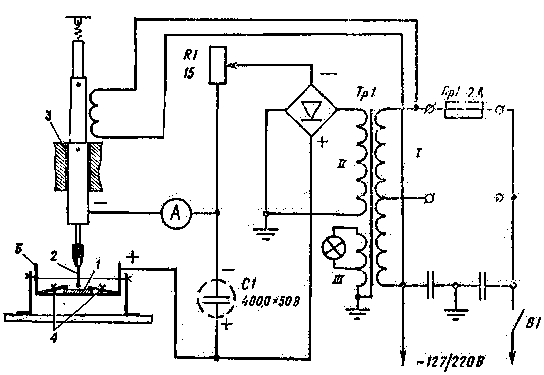Small-sized electric spark installation. Encyclopedia of radio electronics and electrical engineering

Encyclopedia of radio electronics and electrical engineering / welding equipment
 Comments on the article
Comments on the article
A simple electric spark installation (Fig. 1) allows you to easily and quickly process small parts made of electrically conductive materials of any hardness. With its help, it is possible to obtain through holes of any shape, remove a broken threaded tool, cut through thin slots, engrave, sharpen a tool, etc.
The essence of the process of electrospark processing is the destruction of the workpiece material under the action of a pulsed electric discharge. Due to the small area of the working surface of the tool, a large amount of heat is released at the discharge site, which melts the substance of the workpiece. The processing process is most effective in a liquid (for example, in kerosene), which washes the place of contact between the vibrating tool and the workpiece and carries away the erosion products with it. The tool is brass rods (electrodes), repeating the shape of the intended hole.

Fig.1. 1 - workpiece; 2 - tool;
3 - electromagnetic vibrator; 4 clamping device; 5-bath
The circuit diagram of the installation is shown in Fig.2. The installation works as follows. The discharge capacitor C1 is connected with its positive terminal to the workpiece 1. Its minus is connected to the tool 2. The electromagnetic vibrator 3 informs the tool of continuous oscillations. This ensures a constant spark at the point of contact and prevents the tool from welding to the workpiece. The workpiece 1 is fixed in the clamping device 4, which has reliable electrical contact with the bath 5.

Schematic diagram of the installation
The power transformer is assembled on a Sh32 core made of ordinary transformer steel. The thickness of the set is 40 mm. The primary winding contains 1100 turns of PEV 0,41 wire with a tap from the 650th turn. The secondary winding has 200 turns of PEV-2 wire with a diameter of 1,25 mm. Between the primary and secondary windings, a shielding winding III is placed, consisting of one layer wound with a PEV 0,18 wire. The capacity of the discharge capacitor is 400 μF (two capacitors of the KE-2 200X50V type). Rheostat R1 is designed for a current of 3-5 A. This rheostat is wound with a nichrome wire with a diameter of 0,5-0,6 mm on the resistance BC-2.
Diodes D1-D4 type D304, other types of diodes can be used. At the output of the rectifier, the voltage is about 24-30 V. You can use power supplies with a lower voltage, but with a large current, so that the power consumed by the charge circuit is at least 50-60 watts.
During the operation of the installation, continuous sparking occurs. To reduce the interference created by the installation, it is necessary to include simple filters in its power circuit.
Literature:
- V.G.Bastanov. 300 practical tips. Moscow worker, 1986.
Publication: N. Bolshakov, rf.atnn.ru
 See other articles Section welding equipment.
See other articles Section welding equipment.
 Read and write useful comments on this article.
Read and write useful comments on this article.
<< Back
 Latest news of science and technology, new electronics:
Latest news of science and technology, new electronics:
Air trap for insects
01.05.2024
Agriculture is one of the key sectors of the economy, and pest control is an integral part of this process. A team of scientists from the Indian Council of Agricultural Research-Central Potato Research Institute (ICAR-CPRI), Shimla, has come up with an innovative solution to this problem - a wind-powered insect air trap. This device addresses the shortcomings of traditional pest control methods by providing real-time insect population data. The trap is powered entirely by wind energy, making it an environmentally friendly solution that requires no power. Its unique design allows monitoring of both harmful and beneficial insects, providing a complete overview of the population in any agricultural area. “By assessing target pests at the right time, we can take necessary measures to control both pests and diseases,” says Kapil ... >>
The threat of space debris to the Earth's magnetic field
01.05.2024
More and more often we hear about an increase in the amount of space debris surrounding our planet. However, it is not only active satellites and spacecraft that contribute to this problem, but also debris from old missions. The growing number of satellites launched by companies like SpaceX creates not only opportunities for the development of the Internet, but also serious threats to space security. Experts are now turning their attention to the potential implications for the Earth's magnetic field. Dr. Jonathan McDowell of the Harvard-Smithsonian Center for Astrophysics emphasizes that companies are rapidly deploying satellite constellations, and the number of satellites could grow to 100 in the next decade. The rapid development of these cosmic armadas of satellites can lead to contamination of the Earth's plasma environment with dangerous debris and a threat to the stability of the magnetosphere. Metal debris from used rockets can disrupt the ionosphere and magnetosphere. Both of these systems play a key role in protecting the atmosphere and maintaining ... >>
Solidification of bulk substances
30.04.2024
There are quite a few mysteries in the world of science, and one of them is the strange behavior of bulk materials. They may behave like a solid but suddenly turn into a flowing liquid. This phenomenon has attracted the attention of many researchers, and we may finally be getting closer to solving this mystery. Imagine sand in an hourglass. It usually flows freely, but in some cases its particles begin to get stuck, turning from a liquid to a solid. This transition has important implications for many areas, from drug production to construction. Researchers from the USA have attempted to describe this phenomenon and come closer to understanding it. In the study, the scientists conducted simulations in the laboratory using data from bags of polystyrene beads. They found that the vibrations within these sets had specific frequencies, meaning that only certain types of vibrations could travel through the material. Received ... >>
 Random news from the Archive Random news from the Archive panoramic digital camera
04.12.2009
The French optical company "Giroptik" has released a panoramic digital camera that gives a full circular panorama.
The lens is constantly aimed at a hemispherical mirror. After photographing, the result is loaded into a computer and the picture distorted on the mirror hemisphere is converted into a rectangular tape covering the entire horizon around the camera. The photographer himself will also be shot, unless he sets the self-timer to slow down from 10 to 30 seconds and hides during this time.
The quality of the picture, however, is not very high, since 8 megapixels of the photosensitive matrix are "smeared" 360 degrees.
|
 Other interesting news:
Other interesting news:
▪ Video combine from PANASONIC
▪ New laptops
▪ Light radar on a microchip
▪ Shark bite
▪ Leg exercises positively affect the health of the brain and nervous system
 News feed of science and technology, new electronics
News feed of science and technology, new electronics
 Interesting materials of the Free Technical Library:
Interesting materials of the Free Technical Library:
▪ site section Electrician's tool. Article selection
▪ article by Ampère André-Marie. Biography of a scientist
▪ article What are meteorological satellites used for? Detailed answer
▪ Article Poisoning by pesticides. Health care
▪ article Module of electronic switching of tools. Encyclopedia of radio electronics and electrical engineering
▪ article Old battery and its revival. Chemical experience
 Leave your comment on this article:
Leave your comment on this article:
 All languages of this page
All languages of this page
Home page | Library | Articles | Website map | Site Reviews

www.diagram.com.ua
2000-2024







 Arabic
Arabic Bengali
Bengali Chinese
Chinese English
English French
French German
German Hebrew
Hebrew Hindi
Hindi Italian
Italian Japanese
Japanese Korean
Korean Malay
Malay Polish
Polish Portuguese
Portuguese Spanish
Spanish Turkish
Turkish Ukrainian
Ukrainian Vietnamese
Vietnamese


 Leave your comment on this article:
Leave your comment on this article: